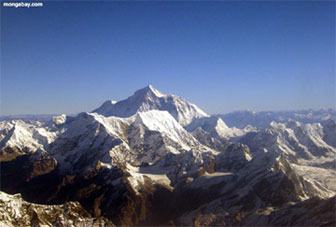New research into climate change in the Western Himalaya and the surrounding Karakoram and Hindu Kush mountains could explain why many glaciers there are growing and not melting.
The findings suggest this area, known as the Upper Indus Basin, could be reacting differently to global warming, the phenomenon blamed for causing glaciers in the Eastern Himalaya, Nepal and India, to melt and shrink.
Researchers from Newcastle University, UK, who publish their findings in the American Meteorological Society’s Journal of Climate, looked at temperature trends in the Upper Indus Basin over the last century.

RELATED ARTICLES Japan, China may be less affected by climate change. Temperature change in East Asian countries may be less significant than in countries bordering the North Atlantic, such as America and Great Britain, according to new research led by scientists at Newcastle University. Researchers examined pollen samples take from a Japanese lake sediment core and found moderate changes in temperature and precipitation during the period from 16,000 years ago to 10,000 years ago, a time that experienced climate change similar to what we expect in the near future. China’s glaciers shrinking by 7 percent per year. The glaciers of China’s Qinghai-Tibet plateau are shrinking by 7 percent a year due to global warming according to a report from Xinhua, the state news agency of China. In an interview with the agency, Professor Dong Guangrong with the Chinese Academy of Sciences warned that melting glaciers could turn parts of Tibet into desert, worsening droughts and increasing the incidence of sandstorms that regularly blast Chinese cities. He based his conclusions based on analysis of 40 years’ worth of data from China’s weather stations. originated, few have researched this topic in Asia. Glaciers melting at alarming rates, water problems feared Global Warming is melting glaciers in every region of the world, putting millions of people at risk from floods, droughts and lack of drinking water. Glaciers are ancient rivers of compressed snow that creep through the landscape, shaping the planet’s surface. They are the Earth’s largest freshwater reservoir, collectively covering an area the size of South America. Glaciers have been retreating worldwide since the end of the Little Ice Age (around 1850), but in recent decades glaciers have begun melting at rates that cannot be explained by historical trends |
They found a recent increase in winter temperatures and a cooling of summer temperatures. These trends, combined with an increase in snow and rainfall – a finding from earlier in their research – could be causing glaciers to grow, at least in the higher mountain regions.
These findings are particularly significant because temperature and rain and snow trends in the Upper Indus Basin also impact on the water availability for more than 50 million Pakistani people.
Melt water from glaciers and the previous winter’s snow supplies water for the summer runoff’ which feeds irrigation both in the mountains and in the plains of the Lower Indus. The vast Indus Basin Irrigation System is the mainstay of the national economy of Pakistan, which has 170,000 square kilometres of irrigated land, an area two-thirds the size of the United Kingdom.
Being able to predict trends could contribute to more effective, forward-thinking management of the two major dams in the Upper Indus Basin – called the Mangla Dam and the Tarbela Dam – and thus allow a better long-term control of water for irrigation and power supplies. These dams have the capacity to produce around 5,000 Megawatts of electric power.
The amount of runoff depends on the elaborate interplay of weather conditions. One third of the runoff – that which comes from the higher mountain regions – is largely dependent on the temperature in the summer, research shows. Specifically, the fall of one degree centigrade in mean summer temperature since 1961 is thought to have caused a 20 per cent drop in runoff into the higher mountain rivers.
Yet two-thirds of runoff – that from the lower mountain regions – is dependent on the amount of snow in the previous winter. Heavy winter snowfall is followed by a greater volume of summer runoff.
Dr Hayley Fowler, lead author on the research paper and a senior research associate with Newcastle University’s School of Civil Engineering and Geosciences, said: “Very little research of this kind has been carried out in this region and yet the findings from our work have implications for the water supplies of around 50 million people in Pakistan who are dependent on the activity of the glaciers.
“Our research suggests we could be able to predict in advance the volume of summer runoff, which is very useful in planning ahead for water resources and also the output from the dams.”
Co-researcher Mr David Archer, a visiting fellow with Newcastle University, added: “Our research is concerned with both climate change and the climate variability that is happening from year to year.
“Information on variability is more important for the management of the water system as it will help to forecast the inflow into reservoirs and allow for better planning of water use for irrigation.
“However, information on the impacts of climatic change is important for the longer term management of water resources and to help us understand what is happening in the mountains under global warming.”













